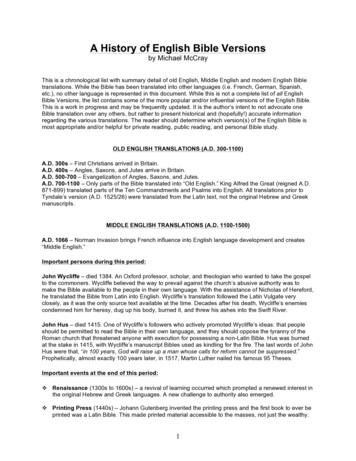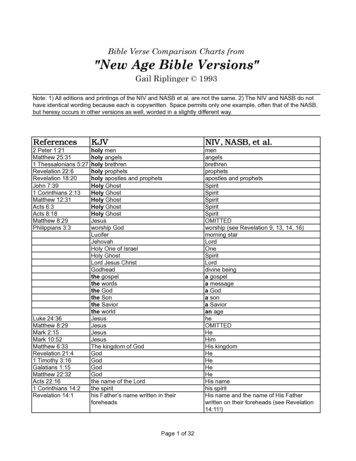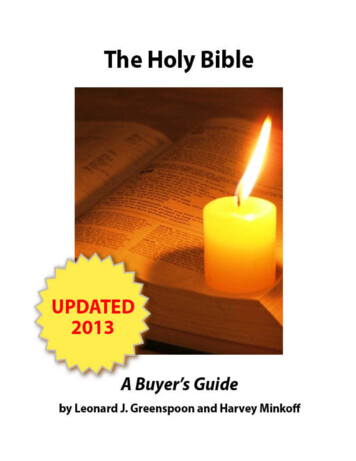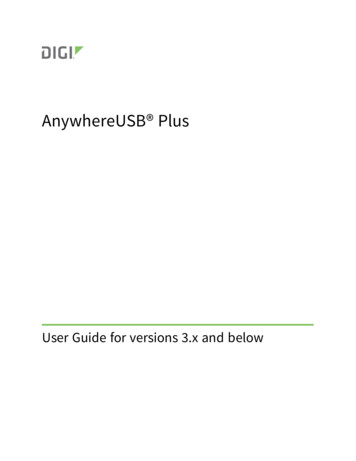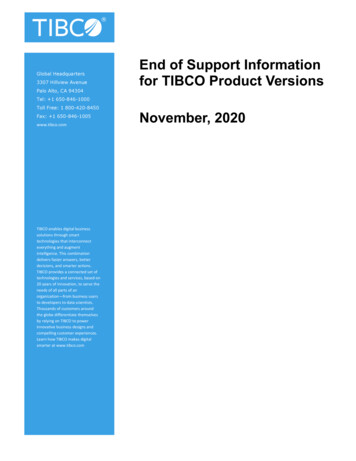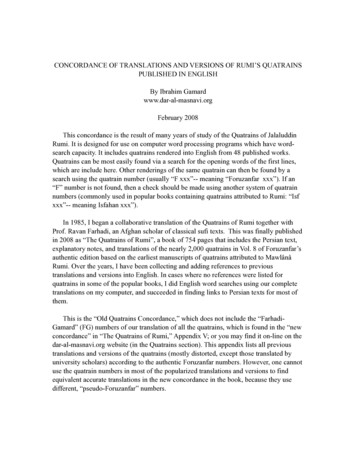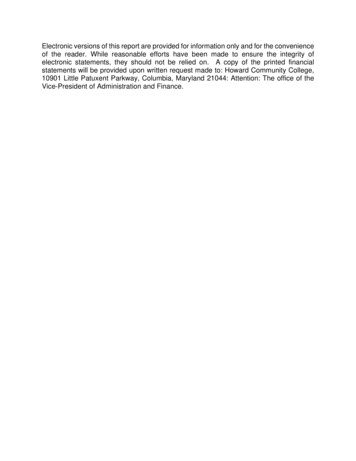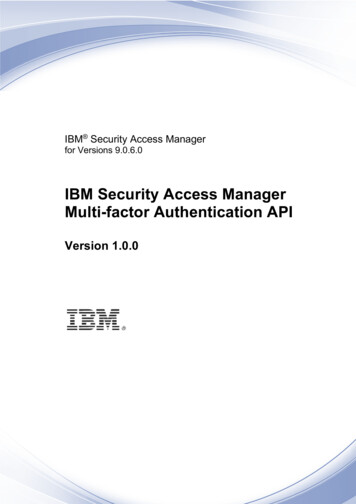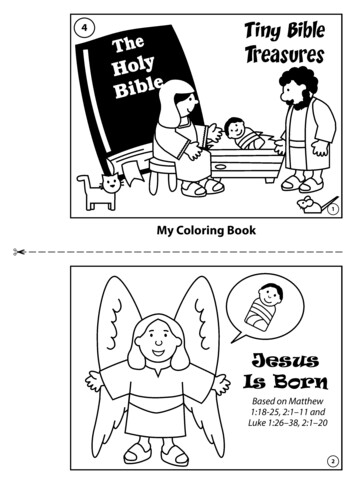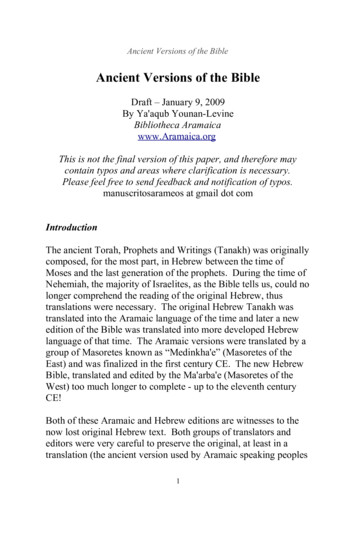
Transcription
Ancient Versions of the BibleAncient Versions of the BibleDraft – January 9, 2009By Ya'aqub Younan-LevineBibliotheca Aramaicawww.Aramaica.orgThis is not the final version of this paper, and therefore maycontain typos and areas where clarification is necessary.Please feel free to send feedback and notification of typos.manuscritosarameos at gmail dot comIntroductionThe ancient Torah, Prophets and Writings (Tanakh) was originallycomposed, for the most part, in Hebrew between the time ofMoses and the last generation of the prophets. During the time ofNehemiah, the majority of Israelites, as the Bible tells us, could nolonger comprehend the reading of the original Hebrew, thustranslations were necessary. The original Hebrew Tanakh wastranslated into the Aramaic language of the time and later a newedition of the Bible was translated into more developed Hebrewlanguage of that time. The Aramaic versions were translated by agroup of Masoretes known as “Medinkha'e” (Masoretes of theEast) and was finalized in the first century CE. The new HebrewBible, translated and edited by the Ma'arba'e (Masoretes of theWest) too much longer to complete - up to the eleventh centuryCE!Both of these Aramaic and Hebrew editions are witnesses to thenow lost original Hebrew text. Both groups of translators andeditors were very careful to preserve the original, at least in atranslation (the ancient version used by Aramaic speaking peoples1
Ancient Versions of the Bibleof the East) or as a modern update (the updated text used today byJewish scribes in writing Torah scrolls). And while they werecareful, or meticulous, it is evident that errors, corruptions andeven removal of certain words and phrases were removed from thewestern version and some major differences appear between theEastern and Western sources.Professor Emanuel Tov, in his book Textual Criticism of theHebrew Bible1, says: “Even though the scribes of MTmeticulously preserved a uniform text, breaches in this unity arenevertheless visible. Between the early sources of MT thereexisted differences in consonants between texts form the West(Palestine) and the texts from the East (Babylon). Some 250 suchdifferences are mentioned in the Masoretic notes as Medinkha'eand Ma'arba'e.”1Published by Uitgeverij Van Gorcum, 2001How old are our Bibles?As mentioned above, the ancient Hebrew text, which no longerexists (at least in whole), dates back to the time of Moses.Various "versions" of this same text (or group of manuscripts)were found at Kirbat Qumran (the Qumran Caves) and aregenerally referred to as the “Dead Sea Scrolls.” The Dead SeaScrolls are a collection of Biblical and non-biblical texts inHebrew, Aramaic and Greek.The date of these manuscripts differ and scholars argue as to theexact dates of each scroll or fragment. There is some generalagreement to many of the manuscripts dating back to the 300'sBCE and the first century CE. In many cases the Aramaic andHebrew texts of the Dead Sea Scrolls agree with the Aramaicversion of the original Hebrew text and against that of the updated2
Ancient Versions of the BibleMasoretic Hebrew text.I postulate that the original Aramaic versions probably date backas far as Nehemiah's time with the necessary updates as thelanguage of the people continued to develop. Its actual originhowever is considered to be a “mystery” by most scholars whotake even the slightest interest in the ancient Aramaic language.On the other hand, the Masoretic Hebrew texts are quite late inexistence. The editing process for the Hebrew MT was completedin the eleventh century.The most complete known Hebrew Bible in existence (theLeningrad Codex) wasn't composed until more than one thousandyears after Messiah1 walked the earth. Yet, the earliest knowncomplete Aramaic version of the Scriptures date back to the fifthor sixth century, which was copied from a much earlier text whichis proof is given in the Dead Sea Scrolls. My great grandfather,Aran Ya'aqub Younan, who adapted the Aramaic Peshitta “NewTestament” from Eastern Aramaic to Judeo-Aramaic (NeoAramaic)2, played with the idea that the Aramaic Tanakh and theearliest manuscripts of the western MT began to be composedaround the same time. On the other hand, my father believed thatthe Aramaic could have been the main source text for MT. Foreither case, I am not yet ready, or comfortable to make an opinionon the matter.1Yeshua ewsyHe began working on his codex in 1897 and the work on the originalconcluded by 1912 or a year before. He was unable to complete the work beforehis death. Younan adapted the Church of the East Peshitta text to Jewish NeoAramaic which is typically written phonetically and replaces certain characterswith others and written with the standard Hebrew alphabet - at least accordingto the spelling and grammatical rules in which he was using.23
Ancient Versions of the BibleWhy choose the Aramaic version over that of the Hebrew?I have always said that “oldest is not always better.” However, ifthere is evidence of more than one textual witness, and thesewitnesses are older than any "updated" version (i.e., the HebrewMT) and they do not agree with a latter version, then we must ingood conscious choose the majority text. There have been severalexamples demonstrating how the ancient Aramaic Tanakh(AN"K) and the Dead Sea Scrolls often times disagree with that ofthe later Hebrew MT.In my opinion, in many cases even some of the targumic texts(Onqelos, Jonathan, Yerushalmi) are better than that of theHebrew MT. The reason I say this is because of so manydisagreements between the ancient witnesses and the more“modern” Hebrew MT. It is well known that the Hebrew MTcontains errors and corruptions as noted above, even though theMasoretes were meticulous in writing the text.Tov says, “Yet, in spite of their precision, even the manuscriptswhich were written and vocalized by the Masoretes containcorruptions, changes, and erasures. More importantly, theMasoretes, and before them the soferim, acted in a relatively latestage of the development of the biblical text, and before they hadput their meticulous principles into practice, the text alreadycontained corruptions and had been tampered with during thatearlier period when scribes did not as yet treat the text with suchreverence.corrupted in the course of the scribaltransmission.Such corruptions are recognized in the Qumranscrolls (e.g., 1QIsaa in Isa 13:19; 26:3-4; 30:30; 40:7-8) on thebasis of their comparison with MT and other texts, and, by thesame token, in MT itself, when compared with other texts.1 Sam1:24; 4:31-22; 2 Sam 23:31; 2 Kgs 11:13; Jer 23:33; 29:26; 41:9.In many details MT does not reflect the 'Original Text' of the4
Ancient Versions of the Biblebiblical books.differences between the Masoretic Text and earlieror different stages of the biblical text will continue to berecognized.”But weren't the Jewish scribes faithful in preserving the originaltext?As has already been noted the scribes (soferim) were from twosets of “Masorete” families - east and west. Many, but not all, ofthe errors and corruptions found within the western text (MT)have been cataloged by various scholars.Christian David Ginsburg noted how the scribes responsible forpreserving and transmitting MT went so far as to even remove theholy Name of God (YHWH hwhy) throughout the Tanakh in atleast 134 passages1, replacing the proper Name with the title“Adonai” (Lord). If these particular scribes were so bold as tomake such a blasphemous act, what other atrocities must theyhave committed in the name of “faithful preservation”?Many a religious individual, especially under the influence ofProtestantism, have a fanciful and near idolatrous view of theHebrew MT in that they imagine the redactors (Masoretes) weredivinely inspired to carefully and perfectly preserve the “Word ofGod.” Many quote the passage in the Gospel of Matthew to basetheir preposterous ideology: “Heaven and earth shall pass away,but my words shall not pass away.” (Matthew 24:35, King JamesVersion).However, as has already been demonstrated above, this was neverthe case with the western text that has been transmitted by theMasoretes. Many of the same corruptions found in the MT havebeen carried over in most of the Christian Bible translations of theHebrew “Old Testament”.5
Ancient Versions of the BibleConcerning the reverence by eastern Masoretes for the holy text ofthe Tanakh, in relation to the Targums, Pinkhos Churgin says inhis Targum Jonathan to the Prophets, “The Aramaic rendering ofthe Prophets belongs to the earliest translations of the Bible whichhave come down to us. Its importance for the textual investigationand early Biblical interpretation cannot be overestimated. Whilethe targumist makes little display of critical study in renderingintricate passages, and while he does not pretend to present aminutely literal translation of the Hebrew text, his reverence forthe letter and transmitted reading of the text must by far haveexceeded that of the Greek and Syriac translators. At the sametime his translation is doubtlessly based on a sounder and exacterunderstanding of both the etymology and usages of the Hebrewlanguage.”2Bible commentator Adam Clarke says of the Masoretes, “TheMasoretes were the most extensive Jewish commentators whichthat nation could ever boast. The system of punctuation, probablyinvented by them, is a continual gloss on the Law and theProphets; their vowel points, and prosaic and metrical accents,&c., give every word to which they are affixed a peculiar kind ofmeaning, which in their simple state, multitudes of them can by nomeans bear. The vowel points alone add whole conjugations to thelanguage. This system is one of the most artificial, particular, andextensive comments ever written on the Word of God; for there isnot one word in the Bible that is not the subject of a particulargloss through its influence. This school is supposed to havecommenced about 450 years before our Lord, and to haveextended down to AD 1030. Some think it did not commencebefore the 5th century A.D.”312See APPENDIX I, "Emendations of the Soferim"Yale University Press, 19076
Ancient Versions of the Bible3The Holy Bible, “Containing the Old and New Testaments. The text carefullyprinted from the most correct copies of the present authorized translation,including the marginal readings and parallel texts: with a commentary andcritical notes; designed as a help to a better understanding of the sacredwritings.” Published by T. Tegg and Son, 1837Is there anything "better" than the MT available?We have the ancient textual witnesses to the original Hebrewfound within the Dead Sea Scrolls, the Aramaic (Medinkhaye)Version and in fragments. As mentioned above, these ancientversions often agree with each other and not with the eleventhcentury MT.When pointing out some differences between the use of aparticular word in the Dead Sea Scrolls (particularly in the GreatIsaiah Scroll) and the Aramaic and MT, demonstrating that theDSS and Aramaic were not in agreement with MT1, Paul Younansaid, “This is clearly a case where the pre-Masorete originalHebrew reading, -x-d [dxs], is attested to by both the POT[Peshitta Old Testament] and LXX [Septuagint]. What makes itirrefutable is the discovery of the DSS Isaiah manuscript, clearlyshowing that the Masoretes had a scribal error here in readingResh for Daleth (a most common error while reading KtavAshuri). Before the discovery of the DSS, all we would have is thePOT and LXX agreeing with each other while disagreeing withthe Masoretic version. This example convincingly demonstratesthat the LXX and POT can be, at times, much more valuable inascertaining the original reading than the Masoretic version.”21See APPENDIX II, “Shakhad in DSS, Pshitta Tanakh and Masoretic Text”2Peshitta.org7
Ancient Versions of the BibleModern day Jews accept the MT - why shouldn't we?Simply because a particular version has become the mainstreamtext of Judaism (from Medieval times to the present) does notindicate that such a text is the most authentic or reliable.Professor Tov says, "[T]he preference of MT by a central streamin Judaism does not necessarily imply that it contains the best textof the Bible. Both the Hebrew parent text of [the Septuagint] andcertain of the Qumran texts. reflect excellent texts, often betterthan that of MT."There are major differences between the ancient Yemenite andBabylonian texts as compared to those used by Judaism in theWest. The Book of Esther is only one example. The differencesbetween the older Yemenite version and that of European Judaism(Askhenazim and Sephardim) are worlds a part from each other.1The editors of the Hebrew text made the conscientious decision tocorrupt various passages of the Tanakh and this was passed downto Christians as can be seen in their modern day translations. TheHebrew manuscripts began to be revised by the Talmudists andMasoretes as early as the third century CE. These same editorswere also responsible for providing Jerome with manuscriptswhich had already been edited for use in his own translation of theVulgate as has been documented by others.Another important factor to remember is how certain translationsof the Hebrew MT were transmitted to Christian and Jewishcommunities throughout Europe in other languages. GeddesMacGregor, in his book, The Bible in the Making, says:“Translations of the Hebrew Bible into various languages, beganto appear about that time. In 1422 Rabbi Moses Arragel translatedthe Scriptures from the Hebrew into Spanish, for the ChristianChurch and with the assistance of Franciscan scholars, and it is8
Ancient Versions of the Bibleupon that version that the Ferrara Bible, printed in 1553, wasbased. This famous Spanish Bible was intended to serve the needsof both Jews and Christians. Certain deviations were made in thecopies intended for Christian readers. For example, where thecopies intended for Jews read 'young wom
Ancient Versions of the Bible Concerning the reverence by eastern Masoretes for the holy text of the Tanakh, in relation to the Targums, Pinkhos Churgin says in his Targum Jonathan to the Prophets, “The Aramaic rendering of the Prophets belongs to the earliest translations of the Bible which have come down to us. Its importance for the textual investigationFile Size: 552KBPage Count: 59

